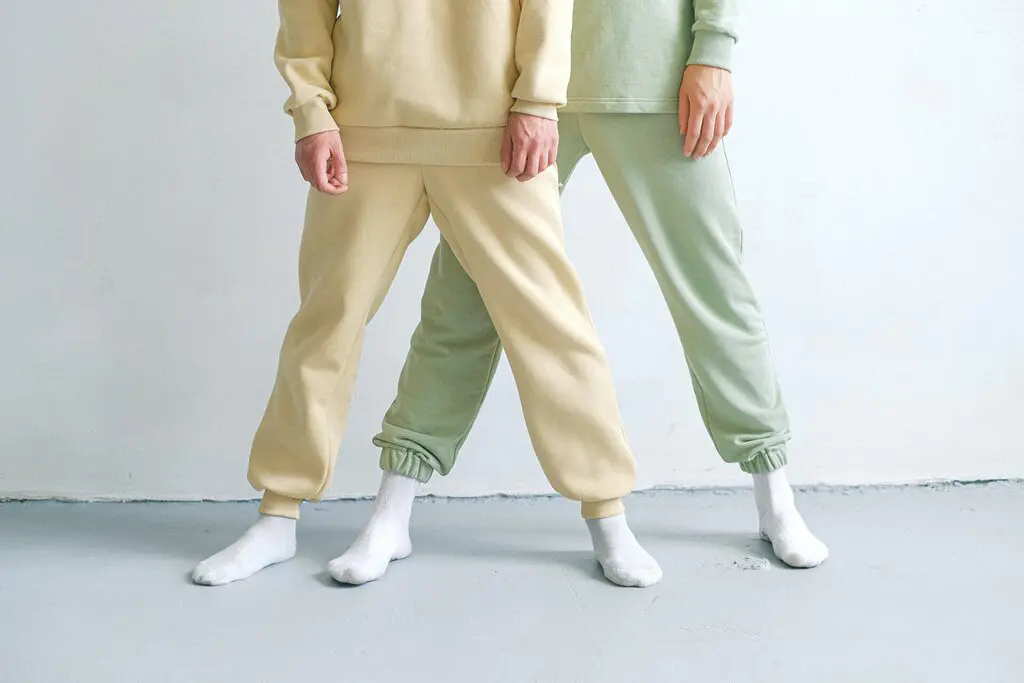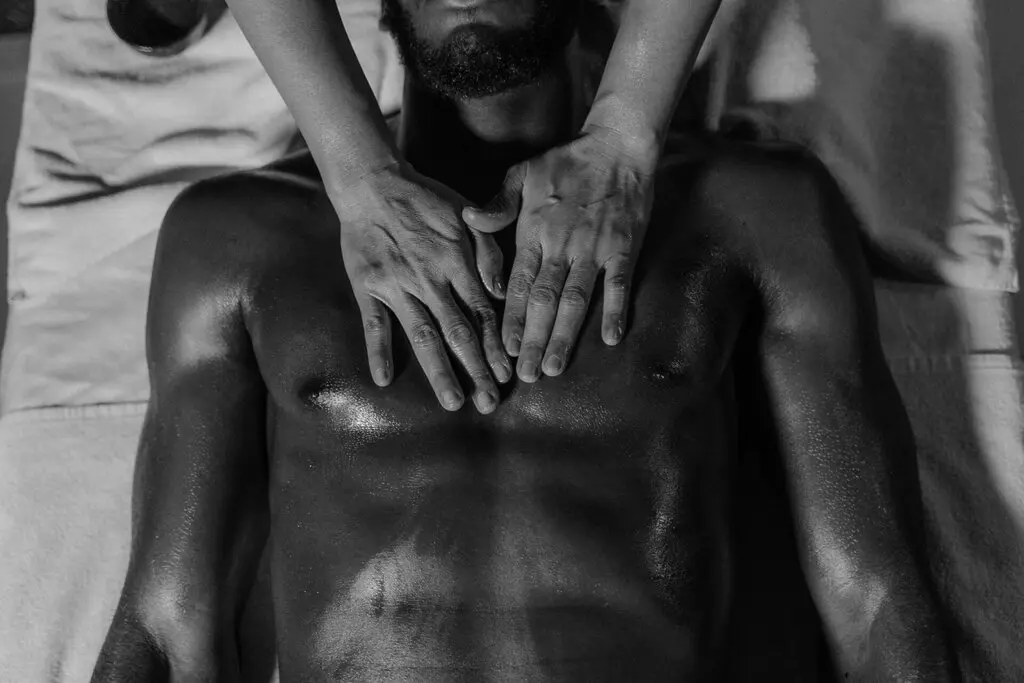Jump to FAQs Table of Contents
- Setting the Stage: Booking Your Appointment
- Arriving Prepared: What to Expect Upon Arrival
- Establishing Boundaries: Respectful Communication During the Massage
- Embracing Relaxation: Navigating Post-Massage Etiquette
- Reflecting on the Experience: Incorporating Massage Therapy Into Your Wellness Routine
- Find your next M4M Massage Therapist
- Frequently Asked Questions
Entering the realm of massage therapy for the first time can be both exciting and nerve-wracking, especially for men who may feel unfamiliar with the etiquette and expectations of the experience. However, understanding the etiquette surrounding male massage therapy is crucial for ensuring a comfortable and beneficial session. In this comprehensive guide, we’ll delve deep into everything you need to know to navigate your first visit with ease, from booking your appointment to post-massage etiquette, empowering you to fully embrace the therapeutic benefits of massage.
1. Setting the Stage: Booking Your Appointment
Before embarking on your massage therapy journey, it’s essential to lay the groundwork by selecting the right therapist or spa and making the necessary preparations for your appointment.
Research and Select a Reputable Massage Therapist or Spa:
Start by researching local massage therapists or spas that offer services tailored to male clientele. Look for establishments with positive reviews and experienced therapists.
Consider factors such as the types of massages offered, the ambiance of the spa, and the qualifications of the therapists.
If possible, seek recommendations from friends or family members who have had positive experiences with massage therapy.
Find your next Male Massage Therapist
Aromatherapy without massage is like an orchestra without a conductor.
Robert Tisserand
Featured Male Massage Cities
-
- Male Massage Professionals in Amsterdam
- Massage in Atlanta, Georgia
- M4M Massage in Brisbane, Australia
- Expert Massage in Cleveland, Ohio
- Male Massage in Dallas, Texas
- Massage Professionals in Las Vegas
- Male Massage in London, UK
- Massage in Los Angeles, California
- Massage in New York City
- Male Masseur in San Francisco, California
- Massage Professionals in Tampa, Florida
Communicate Your Preferences:
When booking your appointment, clearly communicate your preferences regarding the type of massage you desire. Whether you’re seeking relaxation, pain relief, or specific muscle work, your therapist should tailor the session to meet your needs.
Be honest about any health concerns or conditions you may have, such as injuries, allergies, or chronic pain. This information will help your therapist customize the treatment and ensure your safety and comfort.
Prepare for Your Appointment:
Find out if there are any special instructions or preparations required before your massage. For example, you may be advised to shower before your appointment or avoid heavy meals beforehand.
Plan to arrive at least 10-15 minutes early to complete any necessary paperwork and allow yourself time to relax before your session. Rushing to your appointment can heighten stress levels and detract from the overall experience.
2. Arriving Prepared: What to Expect Upon Arrival

As you step into the spa or therapist’s office for your first massage therapy session, knowing what to expect can help ease any nerves and ensure a smooth experience.
Arrive Early and Dress Comfortably:
Aim to arrive at least 10-15 minutes early for your appointment to complete any required paperwork and acclimate yourself to the environment.
Dress in loose, comfortable clothing that is easy to remove, as you will likely be asked to undress partially or completely for the massage. Most massage therapists provide privacy for changing and draping during the session, ensuring your comfort and modesty.
Prepare Mentally and Emotionally:
Take a few moments to center yourself and mentally prepare for the massage experience. Let go of any stress or distractions from the outside world and focus on being present in the moment.
Remind yourself that massage therapy is a safe and professional service designed to promote relaxation, alleviate tension, and improve overall well-being. Trust in the expertise of your therapist and remain open to the healing benefits of touch.
3. Establishing Boundaries: Respectful Communication During the Massage
Once your massage therapy session begins, effective communication with your therapist is essential for ensuring that your needs are met and that you feel comfortable and at ease throughout the experience.
Communicate Your Preferences and Concerns:
Before the massage begins, take a moment to communicate any specific preferences or concerns you may have with your therapist. Whether you prefer lighter or deeper pressure, have areas of tension or sensitivity, or wish to focus on particular areas of the body, your therapist is there to accommodate your needs.
Don’t hesitate to speak up during the massage if you experience any discomfort or pain. Your therapist can adjust the pressure, technique, or focus of the massage to better suit your comfort level.
Remember that your therapist is a professional who is trained to provide therapeutic care with respect and sensitivity. Trust in their expertise and guidance, and feel empowered to advocate for yourself throughout the session.
Respect Your Therapist’s Boundaries:
While it’s important to communicate openly with your therapist, it’s equally important to respect their boundaries and professionalism. Avoid making inappropriate comments or advances during the massage, as this can create discomfort and detract from the therapeutic nature of the session.
Trust that your therapist has your best interests at heart and is focused on providing you with a safe and effective treatment. Maintain a respectful and professional demeanor throughout the session, and allow yourself to fully surrender to the healing power of touch.
4. Embracing Relaxation: Navigating Post-Massage Etiquette
As your massage therapy session draws to a close, transitioning back to the outside world with grace and gratitude is key to maximizing the benefits of your experience.

Take Your Time Getting Up:
After your massage, take your time getting up from the massage table and allow yourself a few moments to reorient before getting dressed. Avoid rushing or abruptly jumping back into your daily routine, as this can diminish the sense of relaxation achieved during the session.
Take slow, deep breaths and gently stretch your body to help release any remaining tension and promote a sense of well-being. Allow yourself to savor the lingering effects of the massage and carry them with you as you move through the rest of your day.
Hydrate and Replenish:
Drink plenty of water after your massage to rehydrate your body and help flush out toxins released during the session. Hydration is essential for supporting the body’s natural healing processes and maintaining optimal wellness.
Consider incorporating other self-care practices into your post-massage routine, such as gentle stretching, meditation, or a warm bath with Epsom salts. These activities can enhance the benefits of your massage and prolong the sense of relaxation and rejuvenation.
Express Gratitude and Feedback:
Before leaving the spa or therapist’s office, take a moment to express gratitude to your therapist for their skill, attentiveness, and dedication to your well-being. A simple thank you can go a long way in acknowledging their efforts and fostering a positive therapeutic relationship.
If you feel comfortable, provide feedback to your therapist about your experience, including any areas of the body that felt particularly tense or any techniques that you found especially beneficial. Constructive feedback can help your therapist tailor future sessions to better meet your needs and preferences.
Consider Tipping:
While tipping practices may vary depending on the establishment and your location, it’s customary to tip your massage therapist as a gesture of appreciation for their services. If you’re unsure about the appropriate amount to tip, a standard range is 15-20% of the total cost of the massage.
Keep in mind that tipping is optional and should reflect your level of satisfaction with the service provided. If you received exceptional care and experienced significant relief or relaxation, consider tipping on the higher end of the spectrum to show your appreciation.
5. Reflecting on the Experience: Incorporating Massage Therapy Into Your Wellness Routine
As you reflect on your first male massage therapy experience, consider the ways in which you can integrate massage therapy into your regular self-care routine to support your physical, mental, and emotional well-being.
Take Note of the Benefits:
Pay attention to how your body feels after the massage and any improvements in mobility, relaxation, or pain relief that you may experience. Massage therapy offers a wide range of benefits, including stress reduction, improved circulation, enhanced flexibility, and relief from muscle tension and soreness.
Keep a journal or mental notes about your massage experiences, including the types of massages you’ve tried, the techniques that were most effective for you, and any changes in your overall health and well-being. This information can help guide your future massage therapy sessions and empower you to make informed choices about your care.
Schedule Regular Sessions:
Consider incorporating regular massage therapy sessions into your wellness routine to maintain the benefits of massage over time. Whether you schedule weekly, bi-weekly, or monthly appointments, consistent massage therapy can help prevent tension and stress from accumulating in the body and promote long-term health and vitality.
Work with your therapist to develop a customized treatment plan based on your individual needs, goals, and preferences. Your therapist can recommend specific massage techniques, frequency of sessions, and self-care practices to support your overall wellness journey.
Communicate and Collaborate:
Establish open and honest communication with your massage therapist about your goals, concerns, and feedback. Your therapist is your partner in wellness and is committed to helping you achieve optimal results from your massage therapy sessions.
Don’t hesitate to speak up if you have questions or concerns about your treatment plan or if you would like to explore new massage techniques or modalities. Your therapist is there to listen, support, and collaborate with you in achieving your wellness goals.

Wrapping up
Navigating your first male massage therapy session may seem daunting at first, but with a comprehensive understanding of etiquette, communication, and self-care practices, you can approach the experience with confidence and curiosity. By following the guidelines outlined in this guide and embracing the therapeutic benefits of massage, you’ll not only enjoy a relaxing and rejuvenating experience but also lay the foundation for long-term health, vitality, and well-being. Remember that massage therapy is a powerful tool for self-care and healing, and by prioritizing your wellness, you’re investing in a happier, healthier, and more vibrant life.
Find your next M4M Massage Therapist
Featured Male Massage Cities
-
- Male Massage Professionals in Amsterdam
- Massage in Atlanta, Georgia
- M4M Massage in Brisbane, Australia
- Expert Massage in Cleveland, Ohio
- Male Massage in Dallas, Texas
- Massage Professionals in Las Vegas
- Male Massage in London, UK
- Massage in Los Angeles, California
- Massage in New York City
- Male Masseur in San Francisco, California
- Massage Professionals in Tampa, Florida
Frequently Asked Questions
Why is it important for men to understand the etiquette of male massage therapy?
Understanding massage therapy etiquette ensures that men can fully relax and benefit from the experience without feeling uncomfortable or uncertain about proper conduct during the session. What are some key considerations when booking a male massage therapy appointment?
It’s essential to research and select a reputable therapist or spa, communicate preferences regarding the type of massage desired, and prepare for the appointment by following any special instructions provided. How should men prepare themselves mentally and emotionally for their first massage therapy session?
Men can prepare by arriving early, dressing comfortably, and taking a few moments to center themselves and let go of stress or distractions before the session begins. How can men effectively communicate their preferences and concerns to their massage therapist during the session?
Men should openly communicate any specific preferences or areas of concern with their therapist before the massage begins and speak up during the session if they experience discomfort or pain. What should men keep in mind regarding post-massage etiquette?
Men should take their time getting up from the massage table, hydrate, express gratitude to their therapist, and consider tipping as a gesture of appreciation for the service provided. How can men incorporate massage therapy into their regular wellness routine?
Men can schedule regular massage therapy sessions, take note of the benefits they experience, and communicate openly with their therapist to develop a customized treatment plan. What are some potential benefits of massage therapy for men?
Massage therapy offers benefits such as stress reduction, improved circulation, enhanced flexibility, relief from muscle tension and soreness, and overall relaxation and well-being. How can men maintain respectful boundaries during a massage therapy session?
Men should avoid making inappropriate comments or advances, respect their therapist’s professionalism, and trust in their therapist’s expertise and guidance throughout the session. What role does hydration play in post-massage care for men?
Hydration is essential for replenishing fluids lost during the massage and supporting the body’s natural healing processes, helping men to maximize the benefits of their massage therapy session. What should men do if they have questions or concerns about their massage therapy experience?
Men should feel empowered to communicate openly with their therapist about any questions, concerns, or feedback they may have, as their therapist is there to listen, support, and collaborate in achieving their wellness goals.
